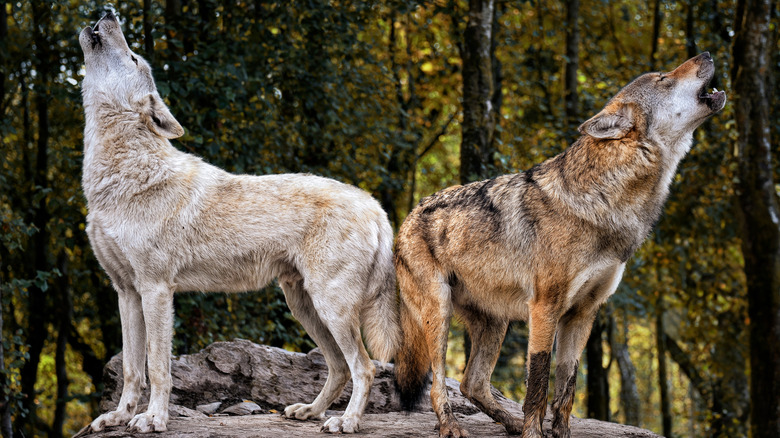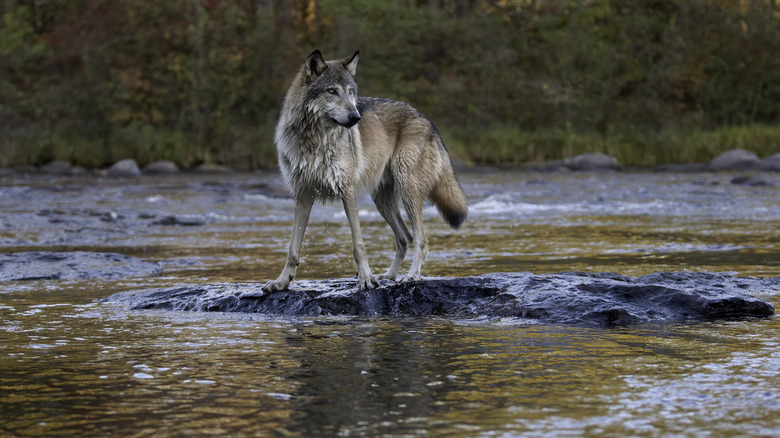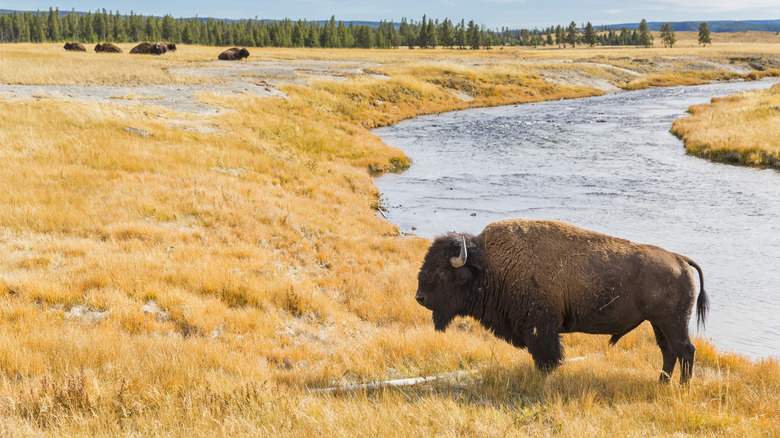How Wolves In Yellowstone Changed The Course Of Rivers
The story of Yellowstone National Park and its wolves is a lesson in the consequences of humans meddling with the world's natural order. Wolves that live in temperate grasslands, specifically gray wolves, were once a defining presence in North America, and at the time Yellowstone became the first official national park in the world in 1872, it boasted a large wolf population. However, anti-wolf sentiment amongst ranchers led to mass exterminations around the country, including in Yellowstone, where the park superintendent actively encouraged wolf hunting to protect animals like elk. While it's true that wolves are a threat to elk, that's just how predator–prey relationships work, and disrupting that relationship is a bad idea.
The last gray wolf pack in Yellowstone was killed in 1926, and it wasn't long before the consequences of removing the top predator from its ecosystem came to light. Without any wolves to hunt them, elk populations skyrocketed and began to overgraze throughout Yellowstone. This had a devastating impact on biodiversity, with the elk leaving little food for other species, robbing pollinating bees of flowers, and leaving fewer nesting spots for birds.
The elk didn't just change the food chain of Yellowstone; they actually changed its geography. Overgrazing along riverbanks led to erosion, clouding the rivers with soil, and the loss of vegetation prevented the local beavers from their traditional dam-building activities. Over decades, this caused subtle changes in Yellowstone's waterways, but then, in 1995, wolves were reintroduced to the park. The results have been fascinating.
What happened when wolves returned to Yellowstone
In 1995, eight gray wolves from Canada were relocated to Yellowstone National Park in an effort to reestablish a local population. More wolves followed in the next year, and today, three decades after the restoration effort began, the park is home to around 100 gray wolves, with an estimated 500 in the Greater Yellowstone Ecosystem, which includes Grand Teton National Park and thousands of acres of additional land within Wyoming, Montana, and Idaho. With the return of the gray wolves, elk overpopulation has been curbed, with the elk population falling from 17,000 in 1995 to just 4,000 three decades later.
The elk that remain in Yellowstone have benefitted in a way — predators force natural selection to weed out weaker members of the species and ultimately lead to a stronger gene pool — but they don't enjoy the carefree life they once did. This is especially apparent around riverbanks, where elk now spend far less time grazing so as not to risk prolonged exposure to their predators. With overgrazing now suppressed, trees that line the riverbanks, like aspens and willows, have grown, and beavers are building more dams. The ripple effect of removing or introducing a predator to an ecosystem is known as a trophic cascade, and Yellowstone appears to be a prime example of it. That being said, some scientists are skeptical of this progress.
Yellowstone's recovery has a long way to go yet
At first glance, the story of wolves returning to Yellowstone seems like the perfect "happily ever after" tale, and a rare example of humans making amends for their climate crimes. However, this view is an oversimplification. For starters, human hunters played a bigger role in reducing elk numbers over the first decade of wolf reintroduction than the wolves themselves did. Furthermore, the rise in beaver dams wasn't solely the result of fewer elk grazing along the riverbanks of Yellowstone, but actually the product of the U.S. Forest Service introducing over 100 beavers to the park at the same time the wolf reintroduction program was getting under way. So, it wasn't so much a trophic cascade descending from a single event, but rather the combined effect of multiple human-driven efforts.
It is also important to note that elk were not the only animals responsible for overgrazing in Yellowstone. Even though elk populations are under control today, there's another animal that is still wreaking havoc on the riverbanks: bison. Much like gray wolves, bison almost went extinct at one point, but they've since made a comeback, and now Yellowstone's bison population is at an all-time high, with over 5,000 individuals, many of them grazing right along the park's waterways. Bison are much bigger than elk, and not nearly as vulnerable to gray wolves, so another solution will have to be found to keep their numbers in check as well.


